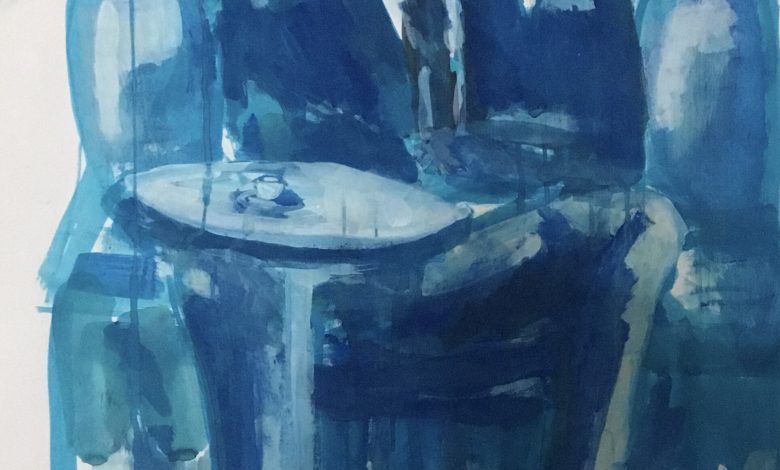

Transforming Reality into Art
The structure and colors in a painting transform reality into art. In Abdel Razek Okasha’s painting, inspired by the neighborhoods of Fatimid Cairo, shades of blue dominate the composition, giving it a dreamy and nostalgic quality.
The choice of blue is not merely an aesthetic decision; it carries symbolic connotations of spiritual depth and serenity. However, in this piece, the blue is imbued with a dynamic movement, evoking the bustling energy of Al-Ataba, Haret al-Yahud, and Al-Hussein, where architectural elements intertwine in a semi-abstract style. Thus, the real-life crowd transforms into a lively dialogue between lines beneath the sky of the canvas.
Okasha gifted me his painting The Thinker, and I find that the urban congestion he dissolved into his blue palette mirrors the crowded thoughts of the figure who tilts his head, burdened by contemplation. This is the same thinker whose presence the artist immortalized in his internationally celebrated artwork.

The Painting Fatimid Egypt
In Okasha’s painting Fatimid Egypt, yellow emerges as a visual counterbalance to blue, creating a harmony between warmth and coolness. The black ink lines—tilted and overlapping—add a sense of movement and noise, reflecting the lively spirit of these historic neighborhoods.
The composition follows a loosely structured pyramidal arrangement, where visual elements intertwine, allowing the viewer’s eye to move freely between different levels. Okasha employs techniques such as stippling and color drizzling, lending the scene a hazy effect, as if these places are being viewed through layers of time and memory. The overlapping black lines create a visual impression of alleys, markets, and walls—essential elements of Fatimid Cairo’s urban fabric. Additionally, faintly human-like figures in the background introduce a human presence within the architectural density, reinforcing the idea of the city as a space for life and interaction, rather than merely silent structures.

Symbolism and Artistic Depth
This painting represents a sensory journey through the historic quarters of Cairo, where the boundaries between past and present dissolve. The use of acrylic and Japanese ink on canvas reflects the artist’s experimental freedom, evoking techniques reminiscent of abstract expressionism—an approach that prioritizes emotional resonance over strict realism. The drizzling technique in certain areas resembles the passage of time or raindrops washing over the city’s features, as if the artist is documenting a moment in the perpetual transformation of space. This method gives the painting a fluid, evolving quality, where details seem to appear and disappear depending on the viewer’s perspective, enhancing the depth of visual engagement.
The painting successfully conveys a sense of movement and vibrancy while maintaining a poetic undertone of nostalgia and contemplation. The viewer feels as if they are strolling through these streets, breathing in the scent of history, and listening to the sounds of vendors and artisans, where the line between vision and memory dissolves. This piece is not merely a visual representation of a place but a sensory and abstract reading of Fatimid Egypt. Okasha delivers it through his unique style, blending modernity and heritage into a contemporary artistic form.

A Parallel to The Thinker
During a Ramadan evening at Darna Museum, founded by artist Abdel Razek Okasha, he gifted me his painting The Thinker. The piece relies entirely on a vast spectrum of blue tones, lending it a sense of tranquility and contemplation while reflecting the intellectual and cerebral depth of the depicted figure. I believed it represented me. The overlapping shades and the effect of color drizzling enhance the abstract nature of the work, blurring the boundaries between figure and background—an artistic decision that suggests the subject’s deep immersion in thought.
The composition centers on a seated figure in a meditative posture, with a table beside them holding a cup—a small but significant detail that adds an intimate and human element to the scene. The forms lean towards abstraction but retain a minimal level of realism, allowing the subject to remain recognizable. The vertical lines in the lower portion, combined with broad, fluid brushstrokes, introduce an internal dynamism, as if thought itself is in motion within the visual space.
The choice of cool colors, particularly deep blue, is traditionally associated with wisdom, calmness, and introspection, making the color itself a narrative tool that conveys the subject’s mental state. The drizzling and stippling effects in the background create the impression that the thinker is lost in their thoughts, with the boundaries of their body dissolving into the contemplative void.
The small table holding the cup may symbolize a pause in the thinking process, or perhaps an internal dialogue unfolding within the subject’s mind. The seating posture—one hand extended while the other remains more hidden—reinforces a psychological depth, reflecting a balance between physical presence and mental engagement.
This painting evokes a profound sense of stillness and self-absorption, capturing a moment of deep thought through a visual language that fuses expressionism with abstraction. The ability to make the viewer perceive an unseen intellectual energy, despite the composition’s simplicity, is one of the painting’s greatest strengths. It invites interpretation, allowing each observer to view it through their own experiences and reflections.
“The Thinker” is not merely a portrait of a person; it is a depiction of a state of mind—a fleeting moment in time transformed into a visual space that draws the viewer into a world of contemplation and existential inquiry



